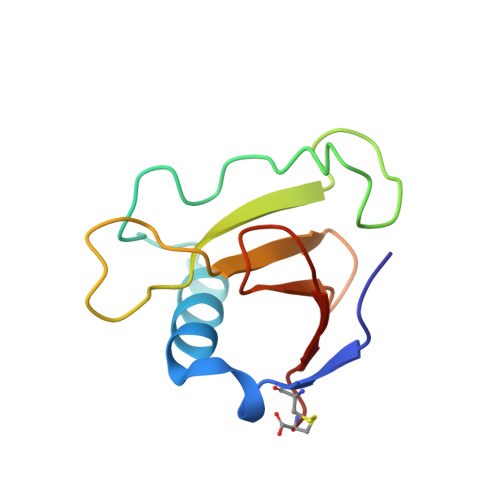The contribution of polar group burial to protein stability is strongly context-dependent
Takano, K., Scholtz, J.M., Sacchettini, J.C., Pace, C.N.(2003) J Biol Chem 278: 31790-31795
- PubMed: 12799387
- DOI: https://doi.org/10.1074/jbc.M304177200
- Primary Citation of Related Structures:
1UCI, 1UCJ, 1UCK, 1UCL - PubMed Abstract:
We previously suggested that proteins gain more stability from the burial and hydrogen bonding of polar groups than from the burial of nonpolar groups (Pace, C. N. (2001) Biochemistry 40, 310-313). To study this further, we prepared eight Thr-to-Val mutants of RNase Sa, four in which the Thr side chain is hydrogen-bonded and four in which it is not. We measured the stability of these mutants by analyzing their thermal denaturation curves. The four hydrogen-bonded Thr side chains contribute 1.3 +/- 0.9 kcal/mol to the stability; those that are not still contribute 0.4 +/- 0.9 kcal/mol to the stability. For 40 Thr-to-Val mutants of 11 proteins, the average decrease in stability is 1.0 +/- 1.0 kcal/mol when the Thr side chain is hydrogen-bonded and 0.0 +/- 0.5 kcal/mol when it is not. This is clear evidence that hydrogen bonds contribute favorably to protein stability. In addition, we prepared four Val-to-Thr mutants of RNase Sa, measured their stability, and determined their crystal structures. In all cases, the mutants are less stable than the wild-type protein, with the decreases in stability ranging from 0.5 to 4.4 kcal/mol. For 41 Val-to-Thr mutants of 11 proteins, the average decrease in stability is 1.8 +/- 1.3 kcal/mol and is unfavorable for 40 of 41 mutants. This shows that placing an [bond]OH group at a site designed for a [bond]CH3 group is very unfavorable. So, [bond]OH groups can contribute favorably to protein stability, even if they are not hydrogen-bonded, if the site was selected for an [bond]OH group, but they will make an unfavorable contribution to stability, even if they are hydrogen-bonded, when they are placed at a site selected for a [bond]CH3 group. The contribution that polar groups make to protein stability depends strongly on their environment.
Organizational Affiliation:
Department of Material and Life Science, Osaka University, and Precursory Research for Embryonic Science and Technology, Japan Science and Technology Corporation, 2-1 Yamadaoka, Suita, Osaka 565-0871, Japan.















